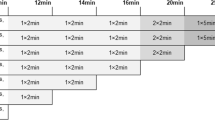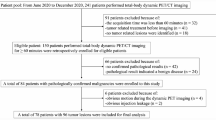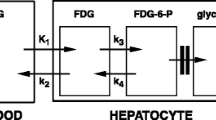Abstract
Purpose: [18F]3′-deoxy-3′-fluorothymidine (FLT) is a thymidine analog developed for imaging tumor proliferation with positron emission tomography (PET). To quantitatively assess images, the blood activities of FLT and its glucuronidated metabolite were measured and its kinetics analyzed. This study sought to limit the number of blood samples needed to measure FLT retention.
Methods: Total FLT activity was measured from 18 venous samples obtained over the first hour and dynamic imaging performed on 33 patients (average dose 350 MBq/mmol). The 5-, 10-, 30- and 60-min samples were analyzed to measure the fraction of activity in FLT and its glucuronide. HPLC analysis was compared against a two-step column (Sep-Pak) and metabolic rates measured using full and limited sampling. Probenecid (2 g, oral) was given to two patients to determine whether imaging of the liver improved.
Results: At 60 min, 74% of the blood activity was unmetabolized (range 57–85%). HPLC and Sep-Pak gave comparable results (r=0.97; average difference 2.1%). For kinetic analysis, eight venous samples were sufficient to accurately measure total activity; for metabolite analysis, a single sample at 60 min yielded data with mean errors of 2.2%. The metabolic rate correlated with average SUV (r 2=0.85; p=0.0002). An aorta input function gave kinetic results comparable to venous blood (r 2= 0.82). Probenecid did not improve imaging of the liver.
Conclusion: Dynamic measurements of FLT retention can be used to calculate metabolic rates using a limited set of samples and correction for metabolites measured in a single sample obtained at 60 min.
Similar content being viewed by others
References
Eary JF, Mankoff DA, Spence AM, Berger MS, Olshen A, Link JM, et al. 2-[C-11]thymidine imaging of malignant brain tumors. Cancer Res 1999;59(3):615–21.
Shields AF, Graham MM, Kozawa SM, Kozell LB, Link JM, Swenson ER, et al. Contribution of labeled carbon dioxide to PET imaging of carbon-11-labeled compounds. J Nucl Med 1992;33(4):581–4.
Wagner M, Seitz U, Buck A, Neumaier B, Schultheiss S, Bangerter M, et al. 3′-[18F]fluoro-3′-deoxythymidine ([18F]-FLT) as positron emission tomography tracer for imaging proliferation in a murine B-cell lymphoma model and in the human disease. Cancer Res 2003;63(10):2681–7.
Shields A, Grierson J, Dohmen B, Machulla H-J, Stayanoff J, Lawhorn-Crews J, et al. Imaging proliferation in vivo with [F-18]FLT and positron emission tomography. Nat Med 1998;4:1334–6.
Vesselle H, Grierson J, Muzi M, Schmidt R, Peterson LM, Pugsley J, et al. F18-Fluorthymidine PET imaging of non-small cell lung cancer: comparison to Ki67 proliferation index. J Nucl Med 2001;42:29P.
Hedaya MA, Elmquist WF, Sawchuk RJ. Probenecid inhibits the metabolic and renal clearances of zidovudine (AZT) in human volunteers. Pharm Res 1990;7(4):411–7.
Grierson JR, Shields AF. An improved synthesis of [18F]FLT. J Labelled Compd Radiopharm 1999;42(Suppl 1):S525–6.
Grierson JR, Shields AF. Radiosynthesis of 3′-deoxy-3′-[18F] fluorothymidine: [18F]FLT for imaging of cellular proliferation in vivo. Nucl Med Biol 2000;27(2):143–56.
Machulla H-J, Blocher A, Kuntzsch M, Wei R, Grierson J. Simplified labeling approach for synthesizing 3′-deoxy-3′-[18F] fluorothymidine ([18F]FLT). J Radioanal Nuclear Chem 2000;243:843–6.
Visvikis D, Francis D, Mulligan R, Costa DC, Croasdale I, Luthra SK, et al. Comparison of methodologies for the in vivo assessment of 18FLT utilisation in colorectal cancer. Eur J Nucl Med Mol Imaging 2004;31(2):169–78.
de Miranda P, Good SS, Yarchoan R, Thomas RV, Blum MR, Myers CE, et al. Alteration of zidovudine pharmacokinetics by probenecid in patients with AIDS or AIDS-related complex. Clin Pharmacol Ther 1989;46(5):494–500.
Selen A, Amidon GL, Welling PG. Pharmacokinetics of probenecid following oral doses to human volunteers. J Pharm Sci 1982;71(11):1238–42.
Morgan DJ, Bray KM. Lean body mass as a predictor of drug dosage. Implications for drug therapy. Clin Pharmacokinet 1994;26(4):292–307.
Gjedde A. Calculation of cerebral glucose phosphorylation from brain uptake of glucose analogs in vivo: a re-examination. Brain Res Rev 1982;4:237–74.
Patlak CS, Blasberg RG, Fenstermacher JD. Graphical evaluation of blood-to-brain transfer constants from multiple-time uptake data. J Cereb Blood Flow Metab 1983;3:1–7.
Shields A, Grierson JR, Muzik O, Stayanoff JC, Lawhorn-Crews J, Obradovich JE, et al. Kinetics of 3′-deoxy-3′-[F-18] fluorothymidine uptake and retention in dogs. Mol Imaging Bio 2002;83–9.
Shields AF. Labeled pyrimidines in PET imaging. In: Valk PE, Bailey DL, Townsend DW, Maisey MN, editors. Positron emission tomography. London: Springer; 2003. p. 715–24.
Lu L, Samuelsson L, Bergstrom M, Sato K, Fasth KJ, Langstrom B. Rat studies comparing 11C-FMAU, 18F-FLT, and 76Br-BFU as proliferation markers. J Nucl Med 2002;43(12):1688–98.
Toyohara J, Waki A, Takamatsu S, Yonekura Y, Magata Y, Fujibayashi Y. Basis of FLT as a cell proliferation marker: comparative uptake studies with [3H]thymidine and [3H]arabinothymidine, and cell-analysis in 22 asynchronously growing tumor cell lines. Nucl Med Biol 2002;29(3):281–7.
Vesselle H, Grierson J, Muzi M, Pugsley JM, Schmidt RA, Rabinowitz P, et al. In vivo validation of 3′-deoxy-3′-[18F] fluorothymidine ([18F]FLT) as a proliferation imaging tracer in humans: correlation of [18F]FLT uptake by positron emission tomography with Ki-67 immunohistochemistry and flow cytometry in human lung tumors. Clin Cancer Res 2002;8(11):3315–23.
Sherley JL, Kelly TJ. Regulation of human thymidine kinase during the cell cycle. J Biol Chem 1988;263(17):8350–8.
Blum MR, Liao SH, Good SS, de Miranda P. Pharmacokinetics and bioavailability of zidovudine in humans. Am J Med 1988;85(2A):189–94.
Schinazi RF, Boudinot FD, Doshi KJ, McClure HM. Pharmacokinetics of 3′-fluoro-3′-deoxythymidine and 3′-deoxy-2′,3′-didehydrothymidine in rhesus monkeys. Antimicrob Agents Chemother 1990;34(6):1214–9.
Author information
Authors and Affiliations
Corresponding author
Additional information
An erratum to this article is available at http://dx.doi.org/10.1007/s00259-006-0335-8.
Rights and permissions
About this article
Cite this article
Shields, A.F., Briston, D.A., Chandupatla, S. et al. A simplified analysis of [18F]3′-deoxy-3′-fluorothymidine metabolism and retention. Eur J Nucl Med Mol Imaging 32, 1269–1275 (2005). https://doi.org/10.1007/s00259-005-1813-0
Received:
Accepted:
Published:
Issue Date:
DOI: https://doi.org/10.1007/s00259-005-1813-0




